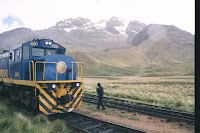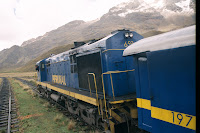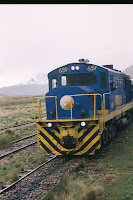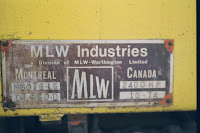Great
Railway Journeys
A
Peruvian Railway Journey
By
Gyan
Fernando
Note:
This article was first written and published on the 26th of February
2002 in my Sri Lanka Railway site. Given the passage of ten years, it needs to
be read as a historical document. The Peruvian Railway system is no longer the highest railway in the world.
T
|
he
Peruvian Railway System is the highest standard guage railway system in the
world. (The Lima-Huancayo-Huancavelica line). Unfortunately terrorist activity
has forced the closure of the most spectacular part of it. What remains is
spectacular in some ways, or at least interesting.
The
author travelled on PeruRail from Cusco to Juliaca on the 19th of Jan 2002 (and
then on to Puno).
The
train, surprisingly, departed on time - after the great photo shoot of posing
on the footplate of the loco, an activity encouraged by the loco engineer with
no oiling of palms involved.
The fact that some of the Gringos recognised the loco as a MLW Bombardier seemed to please the crew! ("Si! Si! MLW Bombardier! MLW Bombardier!")
If
you are a fan of Paul Theroux and are thinking on the lines of "The Great
Railway Bazzar" forget it! This railway journey was undertaken in First
Class comfort and well away from the local smelly third class…sadly.
Still,
that was the only option. It was either that or else maintaining a constant
vigilance about your pockets and belongings to the extent of missing out on the
journey itself! We were of course forced to choose the First Class option.
Cuzco
Cusco
(or Cuzco) (12000ft) has two railway termini. The train to Puno sets off from
Huanchac station at 0800 hrs. The last coach is the Observation Car, an
American style open-ended coach. The penultimate coach is the First Class
accommodation with armchairs, tables and table lamps! Further on are the Orange
and yellow third class coaches - the so-called backpacker specials. First class
coaches are painted in a dark blue and yellow (? gold) livery.
The
locomotives on this route are MLW Bombardiers
 |
| Ticket to Juliaca |
The fact that some of the Gringos recognised the loco as a MLW Bombardier seemed to please the crew! ("Si! Si! MLW Bombardier! MLW Bombardier!")
With
a reverb blast of the air horns the train pulled out of Cusco travelling at a
leisurely 15 mph, clackety-clacking over badly maintained non-welded rails. The
train gently rocked from side to side and fairly soon it was obvious that this
was because the rail joints were not in alignment but (? deliberately)
staggered. Ballast was rather sparse.
Thick
black smoke emanated from the loco. Obviously not warmed up enough or requiring
tuning!
Leaving
the suburbs of Cusco behind the train started a descent and then a serious bit
of climbing through tight curves following the course of the Vilcanota River.
First
class passengers relaxed in comfort. Drinks and snacks were served. Lush fields
of maize passed by. Children stood in the doorways of adobe huts and waved at
passengers. Passengers waved back and talked into their video cameras. Coca
Cola signs in evidence. Quite appropriate as Coca Cola once contained cocaine!
The
train passed through San Sebastion, San Jeronimo and Urcos. Almost continuous
blasts from the loco airhorns sounding a warning at the almost continuous
unguarded level (grade) crossings.
Railway
stations appeared to be only marginally better maintained than the adobe shacks
and could often only be identified by the abandoned passing loops. The train
doesn't stop.
At
first sight signalling does not seem to exist. This is rather worrying.
Old-fashioned derelict semaphore type signals with the air of having seen
better days pass by. Telephone poles are still standing but with the wires
ripped off. Seriously worrying but then the penny drops. Radio signalling is
the clue! Not a bad railroad one thinks!
 |
| Turntable at Sicuani |
The
train slowed down for Sicuani, a bustling town at an elevation of 3542 M.
Colourful markets on either side of the tracks. Local smart arsed teenagers
shout "Gringo!" or rather "GreeenGo!"
An
old-fashioned railway yard with a turntable passes by. Armed guards close gates
to railway yard as soon as the train enters.
Abra La Raya
 | |
| Abra La Raya |
From
Sicuani the train climbs to the summit at La Raya (3906 M). First class
passengers are served with a three course lunch. The train on this day waited
for the crossing with the Puno-Cusco train at La Raya.
The
train is now on the Altiplano. Hawkers surround train. Loco horns from both
trains play a duet and reverb eerily around the mountains.
 |
| Crossing at La Raya |
 |
| Crossing at La Raya |
 |
| Crossing at La Raya |
 |
| Dog supervises departure of trains! |
 |
| Church at La Raya |
After
the crossing, the train sets off across the Altiplano. The Vilcanota River
disappears as a trickle in the marshes. Soon the train descends and at Santa
Rosa picks up the start of the Santa Rosa River. The Santa Rosa River
eventually joins the Pucara River and drains into Lake Titicaca. The track is
straight now with gentle gradients, which is surprising as the train is at a
very high elevation.
 |
| Tornado on the Altiplano |
On
this day the skies lowered and a tornado appeared suddenly on the Altiplano. By
the time the train got there the tornado had dissipated with no visible damage.
There was nothing to be damaged. Unconcerned "Indians" continued
their work in the fields.
 |
| Joanna, our charming rail attendant. |
Juliaca
The
train trundled along and very soon we arrived at Juliaca. Sadly, we left the
train here to continue by road to Puno but the train followed us skirting the
edge of Lake Titicaca. Darkness fell. This had been a 9+ hours rail journey.
The final glimpse of the train was near Puno...just the twin headlamps...We
were now in Puno and on our way to the Hotel Libratador and the Coca tea!
 |
| Lake Titicaca at sunset as seen from Puno |
Technical note: The reason that we
left the train at Juliaca is because the train is usually delayed here for an
hour or so whilst the loco does shunting duties but on this day the train set
off without too much delay.



No comments:
Post a Comment